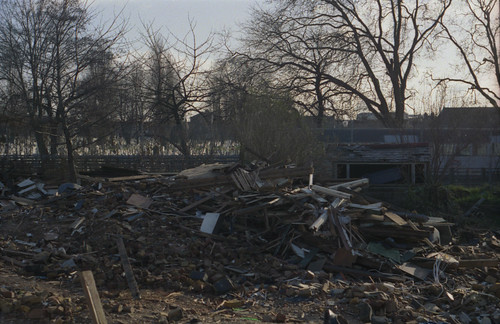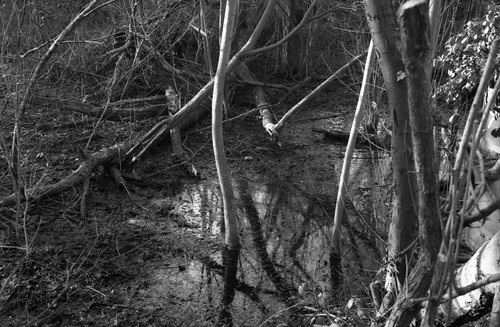 |
| Kentmere Pan 100 35mm film |
It's become something of a commonplace to describe how the ongoing coronavirus pandemic has altered the perception of time, simultaneously stretching and squashing it, making everything from 'before' feel unusually distant, separated. I wrote a post in November 2019 about
Kentmere Pan 400 after its rebranding, with the prominent 'pan' added to the name, and in it I compared this to the
Ilford Pan 400 film I'd written about previously (being one of two cheaper Ilford films which had only recently then become more widely available in the UK, while the point of comparison being that the Kentmere films are made by Harman, Ilford's parent company at a similar lower price than Ilford's other films); having heard that these-the Ilford Pan films-were to be discontinued, naturally, I then wanted to write about Kentmere Pan 100 as a logical comparison to
Ilford Pan 100 and as a companion to the Kentmere Pan 400 post. I hadn't used the slower Kentmere film as much as the 400 previously, and I began as I would with any other film new to me, by exposing a roll for a latitude test. This was done on the day (check) that my work announced that they were moving from being face to face to online for the forseeable future, a week before the UK government issued its general 'stay at home' order.
Subsequently, I used Kentmere Pan 100 quite a bit over the next year and a half, in early autumn 2020, as the initial restrictions were eased and I went back to working face to face, as part of my plan to use the
Olympus Pen EE3 half frame camera for the year leading up to the tenth anniversary of this blog, then at the start of 2021 when restrictions were back and I was recovering from my first Covid infection, taking allowed walks for exercise, and taking a camera with me. I had long planned to write this post after having used the film as much as I had; I had thought I should do so as the second anniversary of the pandemic and my first test of the film came around in March this year, but that came and went.
 |
| Kentmere Pan 100 in medium format |
Then, at the start of this month, on December 1st, Ilford announced that the Kentmere films were being produced in medium format, having only been previously available in 35mm. This provided the motivation to finish this post, and to add the medium format results to it, and, although I have so far only shot a single roll in medium format, all the tests made so far on 35mm film obviously are still relevant.
 |
| Kentmere Pan 100 latitude test contact sheet |
I made the latitude test using the
Canon A-1; compared to Ilford Pan 100, Kentmere Pan 100 does appear to show greater latitude, although the test was slightly marred by one set of frames being double exposed somehow. The top row of frames on the contact sheet above were exposed at 12-25-50-100-200-400 and developed in Ilfotec LC29 diluted 1+19 for 7 minutes at 20ºC. The lower three rows were rated at box speed, but with some bracketing. One stop either side of box speed scanned well; at 400, the shadow detail starts to look lacking, while at 25, two stops overexposed, the midtones and highlights start to look less separated, making scanning a little more difficult, but probably still printable with some care. In comparison with Kentmere Pan 400, the 100-speed version has less latitude, which is probably in part a function of its contrast, with higher speed films generally being lower in contrast by their nature.
As part of my usual testing of film stocks, I pushed–and pulled–Kentmere Pan 100. I used the film quite a bit during the winter months of 2020-21, and as a result, pushing the film often made sense in terms of working with available light. My first attempts at pushing one stop to 200 and used Ilfotec LC29, which appeared to provide a little more contrast, although most of the photographs taken on that first pushed film were in autumn sunshine, with bright light but relatively low, against deeper shadows. This did suit some of the subjects, as in the second image below.
 |
| Canon A-1 with Kentmere Pan 100, rated 200, Ilfotec LC29 1+19, 8m 20ºC |
 |
| Canon A-1 with Kentmere Pan 100, rated 200, Ilfotec LC29 1+19, 8m 20ºC |
The second roll of Kentmere Pan 100 at a rating of 200 was developed in exactly the same way, but using the
Voigtländer Vito B, with an older lens from the Canon A-1's standard FD-fit 50mm f1.8 lens gave a different feel to the images. These photographs were taken on a couple of bright days in very early January, with very low sunlight, and it might have been more appropriate to
pull the film to lower the contrast for many of these images (the top image being of a lower-contrast subject perhaps demonstrates this), but I'd decided to push the film without considering what the weather conditions might be: the results were not unsympathetic however.
 |
| Voigtländer Vito B with Kentmere Pan 100 rated 200, Ilfotec LC 29 1+19, 8m 20ºC |
|
 | | Voigtländer Vito B with Kentmere Pan 100 rated 200, Ilfotec LC 29 1+19, 8m 20ºC |
|
As I used the Kentmere Pan 100 over quite a number of months, as well as the different tests, I also used a few different developers, not with the intention of comparing the results, but more simply being the case that I was using whichever black and white developer I currently had in use. It would have been instructive to have been more programmatic in this regard, but I hadn't thought that my testing of the film would have occurred over quite such a long period of time. Harman's own data sheet for Kentmere Pan 100 does not provide any timings for a two-stop push to 400 (the metal 35mm canister does have a box next to that 100 and 200 to mark an exposure rating, logically for 400), but this would be a good comparison to the Ilford Pan 100 film. For that particular film, I estimated an extended development time using Ilfotec LC29, with what I felt at the time were rather mixed results. I tried a different approach then with semi-stand development. I used R09 One Shot diluted to 1+150 for 3 hours, agitating on each hour interval (a method used previously with Ilford HP5 Plus: the theory behind using such a high dilution of Rodinal is to reduce the contrast that accompanies push-processing; no doubt most of the development has occurred by the one-hour stage, but I wanted to give the shadow areas as much opportunity to develop as possible). I did the same with Kentmere Pan 100.
 | | Canon A-1 with Kentmere Pan 100, rated 400, 3 hours semi-stand development Adox Rodinal 1+150 |
|
 |
| Canon A-1 with Kentmere Pan 100, rated 400, 3 hours semi-stand development Adox Rodinal 1+150 |
The results (above) were comparable to the approach with the Ilford Pan 100 film, and there's a smoothness to the grain which suggests this to be sympathetic to rating the film at 400, given all the caveats one would want to make in relation to push processing. However, I've not tried a more conventional development regime for a two-stop push with this film to see what the difference might be against this extended semi-stand development.
There are probably more conditions under which one might push a film, compared to pull-processing, but I did also try this with Kentmere Pan 100. As regards the comments above with the one-stop push with the Vito B camera, the roll which I rated at 50 might have been better with higher contrast subjects–as pulling a film reduces its contrast–most of this roll of the film was shot under overcast conditions in January. I used the
Kiev-4 rangefinder for this, and it may be a fortuitous combination of lighting conditions, reduced development, and the lens used (the Helios-103), but the results pulled one stop in Rodinal appeared to me to be both smooth
and sharp, and possibly represents an achievable look of Kentmere Pan 100 that, of all the different exposure/development combinations I've tried while testing the film, I liked the most (the real test would be to print in the darkroom of course).
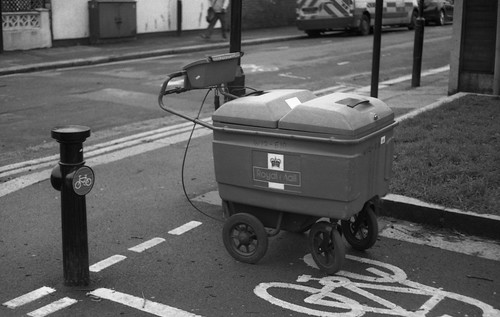 |
| Kiev-4 with Kentmere Pan 100 rated 50, Rodinal 1+50, 9m 20ºC |
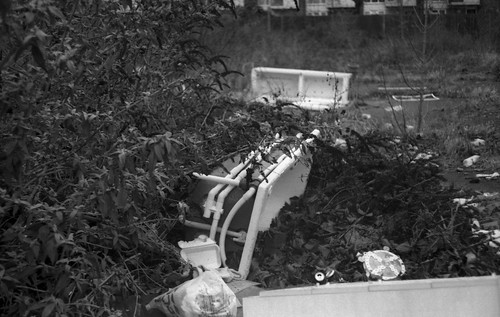 |
| Kiev-4 with Kentmere Pan 100 rated 50, Rodinal 1+50, 9m 20ºC |
I also used the film with a couple of 35mm half-frame cameras, and the relatively fine grain made the film sympathetic to the smaller frame size, although the film used in the
Olympus Pen EE3 coincided with that camera's lens becoming loose and providing slightly-out-of-focus images. This was part of my year-long re-engagement, an ultimately frustrating one, with the Pen EE3, with the Kentmere Pan 100 film being one that I had in my camera through the summer of 2020.
 |
| Olympus Pen EE3 with Kentmere Pan 100, Ilfotec LC29 1+19, 9m 18ºC |
 |
| Agat 18K with Kentmere Pan 100, Ilfotec LC29 1+19, 7m 20ºC |
As written about at the start of this post, what made me finally gather all the images together and write this post was the introduction of Kentmere Pan 100 in medium format rollfilm. As with the 35mm version of the film, this is clearly intended to compete with other lower priced films currently available, and no doubt it makes sense for Harman to be part of that market for medium format. Just over a week ago, on the shortest day of the year, I shot a roll of medium format Kentmere Pan 100 with the
Voigtländer Bessa rangefinder. If it hadn't been for this particular post, a 400-speed film would have been better for the lighting conditions, as, on an overcast day in the middle of winter, I found I was having to use a slower shutter speed or wider aperture than I might have liked, and was using the camera hand-held too.
 |
Voigtländer Bessa with Kentmere Pan 100, Kodak HC-110, 1+31, 5m45s at 22ºC
|
However, medium format can be quite forgiving and returning to the film in that new format, the results of which were very promising–the film dried flat, and was easy to scan, and I suspect as a choice of emulsions, I'd be more likely to choose Kentmere Pan 100 in medium format perhaps more so than in 35mm in future. As a lower-priced film stock, Kentmere Pan 100 fits a gap, especially given the current circumstances as I write, but I generally feel it's relatively unremarkable–it doesn't compare to Ilford FP4 Plus or Delta 100 as Harman's similar speed films–but as I've written above in relation to pulling it to a rating of 50 with the Kiev-4, with judicious exposure and development the results can be better than one might expect for a 'budget' black and white film, which makes its introduction into medium format (as with Kentmere Pan 400) all the more welcome.
 |
| Kiev-4 with Kentmere Pan 100 rated 50, Rodinal 1+50, 9m 20ºC |
 |
| Siluet Elektro with Kentmere Pan 100, rated 80, Rodinal 1+50 15m 20ºC |
 |
| Olympus Pen EE3 with Kentmere Pan 100, Ilfotec LC29 1+19, 9m 18ºC |
 |
| Agat 18K with Kentmere Pan 100, Ilfotec LC29 1+19, 7m 20ºC |
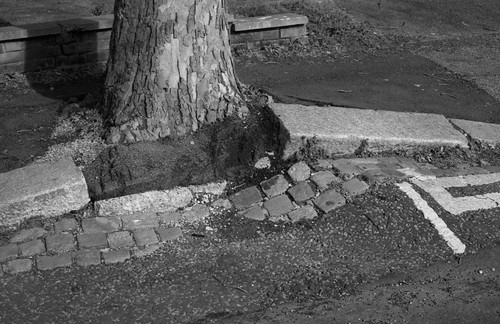 |
| Canon A-1 with Kentmere Pan 100, Ilfotec LC29 1+19, 7m 20ºC |
 |
| Kodak Retina IIa with Kentmere Pan 100, Ars-Imago #9 (Rodinal formula) 1+50, 15m 20ºC |
 |
| Voigtländer Vito B with Kentmere Pan 100 rated 200, Ilfotec LC 29 1+19, 8m 20ºC |
 |
| Canon A-1 with Kentmere Pan 100, rated 200, Ilfotec LC29 1+19, 8m 20ºC |
 |
| Canon A-1 with Kentmere Pan 100, rated 400, 3 hours semi-stand development Adox Rodinal 1+150 |
 |
| Voigtländer Bessa with Kentmere Pan 100, Kodak HC-110, 1+31, 5m45s at 22ºC
|







